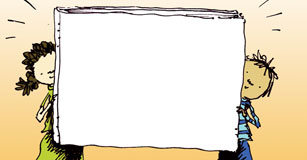Create Stop-Motion Animated Stories
Motivate and engage boys with technology

“19 of 21 boys who talked about liking school said they did so because of the social dimension of schooling.”
—M.W. Smith and J.D. Smith, Reading Don’t Fix No Chevys
In almost every classroom you will find a small group of boys who, for various reasons, either can’t or won’t write with paper and pencil. In some situations “won’t write” actually means that their writing output is nothing. Absolutely nothing.
There are a number of conditions that need to be present for successful learning among boys. Barry MacDonald, in his book Boy Smarts: Mentoring Boys for Success at School describes the “Cs” of motivating boys. For boys to be internally motivated, they need to feel competent, capable, connected, and that they count.
After spending many years reading, researching, and observing classrooms, I have developed a passion for animation projects where boys are tasked with telling a story with their favorite toy characters. Add stop motion animation software, a laptop, and a video camera, and the result is engaged learners who are motivated to tell a story.
These opportunities for multimodal expression engage boys by providing them with an opportunity to be active and social as they discuss, plan, and execute a project. Using their favorite characters helps them make a personal connection to the content they are responsible for sharing with others.
A typical experience
In small groups, students storyboard scenes for their animation. Each group brainstorms suitable ideas and develops a story that has a beginning, middle, and end.
During the planning and storyboarding phase of the project, there is always active conversation among team members about which camera angles should be used, which kinds of action sequences should be included, and what type of toy characters, like Lego® or Playmobil®, they have at home that can be used for each scene.
Once the planning and storyboard are complete, materials are set up, and a rough idea of the story is in place, it is time to start the animation process. The boys place their characters on the stage and use Frames to capture sequences of webcam photos to tell their story. They work to adjust the duration and add narration to create a complete animation. The topics are open-ended and varied, but always include lots of action.
The process is also full of action as team members work to move characters, take pictures, and direct the action. The room is filled with noise as the boys discuss how and where characters should be placed in the scenes and what angles should be used to capture the action.
To build an animation successfully in the allotted time, the boys have to assign jobs among group members. Often there is one group member controlling the laptop and software and another operating the camera to make sure the angle is correct and camera is focused. Two or three other group members move the characters to create the story. Even though the jobs are assigned, all boys participate in telling the story and refining it along the way.
Students are connected with their social group and feel capable since they are working with materials they are familiar with and have hands-on use of cameras and laptops. It is common to hear teachers and assistants claim, “I haven’t seen that group of boys engaged in a task like this all year long!”
Trying this in your classroom
You don’t need a lot of fancy equipment for a project like this. An inexpensive web camera can be used, you can download an evaluation version of Frames, and almost any computer you have will work, both Mac and PC. Most importantly, as Ralph Fletcher says, be prepared for mayhem and action in the content of the stories and be prepared to be flexible with topic choice for your boy learners.
Text can come in a variety of forms: traditional text-only print, multimedia text that includes audio and visuals, spoken text, and more. A visual-only representation of events can also be interpreted as text, since it can tell a story. Expanding our definitions of text and writing can help us engage our boy students, helping them develop strong thinking, organization, and collaboration skills, as well as provide an opportunity to practice essential 21st century communication.
Bibilography
Macdonald, B. (2009) Boy Smarts: Mentoring Boys for Success at School.
Surrey BC: Mentoring Boys Press.
Smith, M. W. and Wilhelm, J. D. (2002) “Reading Don’t Fix No Chevys”: Literacy in the Lives of Young Men.
Portsmouth: Heinemann.













